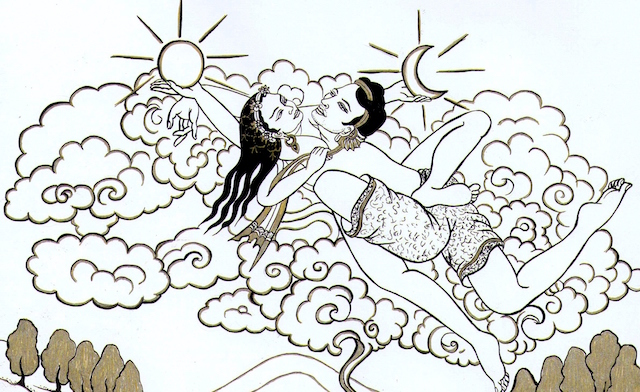From the perspective of Vajrayana, if a woman has a strong aspiration and the necessary karmic prerequisites to overcome the instinctive need for procreation, her capacity for higher awareness is greater than that of a man. But even if she does choose to be a mother, she still has a chance to use her karmic situation to attain the state of Buddhahood.
Many contemporary Vajrayana teachers stand behind such statements, including His Holiness the 14th Dalai Lama, who has said on numerous occasions that women have greater potential, more sensitivity about others’ well-being, and greater compassion than men. Another question is how such philosophical concepts are reflected in the real social life of Buddhist women. As for their religious life and in particular ritual practice, their role remains shrouded in mystery, especially in the annals of history.
The woman, as a spiritual partner or consort in Tibetan Buddhist practice, has various symbolic names. She is called dakini (Tib. khandroma), yogini (naljorma), “seal” or mudra (chagya), “transcendental wisdom” (sherab), “awareness” (rigpa), “goddess of awareness” or vidyadevi (rigpe lhamo), and “awareness holder” (rigdzinma). In the Tibetan tantric tradition, the consort is also called “secret mother” or sangyum, a term often used for wives of senior teachers or treasure revealers (terton).
In many cases, the role of the consorts is to remove obstacles related to the health, the spiritual practice and Dharma activities of their partner. Traditionally it is believed that consorts are called “secrets” not because they are hidden, but because they help to uncover a deep wisdom that is sacred. As Dzongsar Khyentse Rinpoche says: “The secret is what creates the sacred.” Vajrayana itself is called Secret Mantra Diamond Vehicle (sangngag dorje thegpa) because of the esoteric nature of its teachings. They are secret in the sense that their importance is not available for those who have not received proper instructions. Vajrayana is traditionally considered as secret not because there is something that has to be hidden, but to protect the practitioner from confusions that the ego can cause in regard to the spiritual practice. The secret aspect of sangyum concerns the esoteric nature of the practices in which she may participate, and also her often hidden or secondary role in society. Some of the Tibetan Buddhist teachers keep their wives secret and in this context they can be referred to as: “secret consort in a hidden form” (sangyum betshul).
In Vajrayana, the female principle is embodied in four types of women known as four mudras (chagya shi). In the system of Yoga Tantra, they are accepted as tools that “seal” the enlightened body, speech, mind and qualities of the Buddhist deities and help for the realization of their potential. They are described as “lovers” with whom the yogi must perform an unconditional union. The four mudras are: karmamudra (lekyi chagya), jnanamudra (yeshe chagya), dharmamudra (chokyi chagya) and mahamudra (chagya chenpo).
Karmamudra is a real woman associated with the practice of Tantric union. Jnanamudra is an imaginary woman related to the practice of meditation. Dharmamudra is connected with the elimination of mental delusions and realization of wisdom. Mahamudra is the female principle, beyond duality, which is the epitome of emptiness. Her essence is described as eternal and indestructible and, like the entire cosmos, it is not characterized by independent existence but by the interdependent origination of all phenomena and all-encompassing space.
In Vajrayana, the necessity to distinguish between these female aspects is eliminated at the higher stages of spiritual realization, where the various mudras are accepted in their real nature – the emptiness. The state, in which all forms are perceived as manifestations of emptiness, is described as mahamudra or “the great symbol.” In Buddhism, the whole world is seen as a symbol that becomes reality itself and a vivid image of things as they are.

